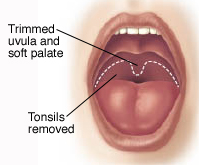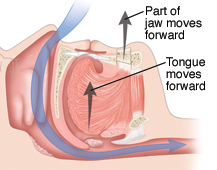Surgical Treatment for Snoring and Sleep Apnea
Surgical Treatment for Snoring and Sleep Apnea
The goal of most types of surgery for sleep is to widen the airway. This is so you can breathe more easily. Surgery is done by taking out or shrinking excess tissue where the mouth meets the throat. Nasal and jaw surgery can help correct nose or jaw problems that lead to snoring and apnea. This sheet describes procedures that may be advised for you.
UPPP |
Jaw surgery |
Uvulopalatopharyngoplasty (UPPP)
This is the most common surgery for sleep apnea. It trims the soft palate and uvula, and removes the tonsils and other tissue. It is major surgery done in a hospital. Most people go home within 24 hours.
Risks of UPPP
Problems are not common with this surgery. But risks include:
Bleeding
Throat pain
Scarring
Nasal-sounding speech
False feeling that something is in throat
Liquids sometimes going into nose when swallowing
Laser-Assisted Uvulopalatoplasty (LAUP)
This surgery helps relieve snoring. It may also be used in some cases of mild apnea. The doctor uses a laser or electric current to remove some of the soft palate and part or all of the uvula. This surgery may be done over several sessions in the doctor’s office.
Risks of LAUP
The risks are the same as for UPPP, but less likely to occur.
Radiofrequency Ablation (RFA)
This procedure helps relieve snoring. The doctor uses radio waves to reduce the size of the turbinates or uvula, nearby tissue, and sometimes the back of the tongue.
Risks of RFA
Mouth ulcer
Nerve pain
Swelling in airway
Pocket of pus (abscess) on tongue
Nasal surgery
Problems in the nose can make snoring or sleep apnea worse. They can also make a CPAP harder to use. A CPAP is a machine that sends pressurized air through a face mask as you sleep. If blockages in your nose are severe, surgery can improve the airflow. It can reduce the size of the turbinates, straighten a crooked (deviated) septum, and remove any polyps. Polyps are overgrowths of sinus lining.
Risks of nasal surgery
Bruising
Bleeding
Damage to or hole in the septum
Dryness in nose
Jaw surgery
If your jaw sits too far back, your tongue may also be too far back. That makes your tongue more likely to block your airway when you sleep. Moving your jaw forward moves your tongue forward and widens the airway overall.
Risks of jaw surgery
In some cases, the jaw does not heal in the desired position. Your healthcare provider can tell you more about this. Other risks include:
Loss of teeth
Need for orthodontic treatment to realign teeth
Loss of feeling in jaw or teeth
Change in facial appearance
More severe cases
If your apnea is severe and no other treatment helps, other kinds of surgery may help. Your healthcare provider can tell you about them. Be sure you understand their risks as well as their benefits.
Updated:
October 24, 2017
Sources:
Snoring in adults, UpToDate
Reviewed By:
Blaivas, Allen, DO,Image reviewed by StayWell medical illustration team.,Taylor, Wanda L, RN, Ph.D.

